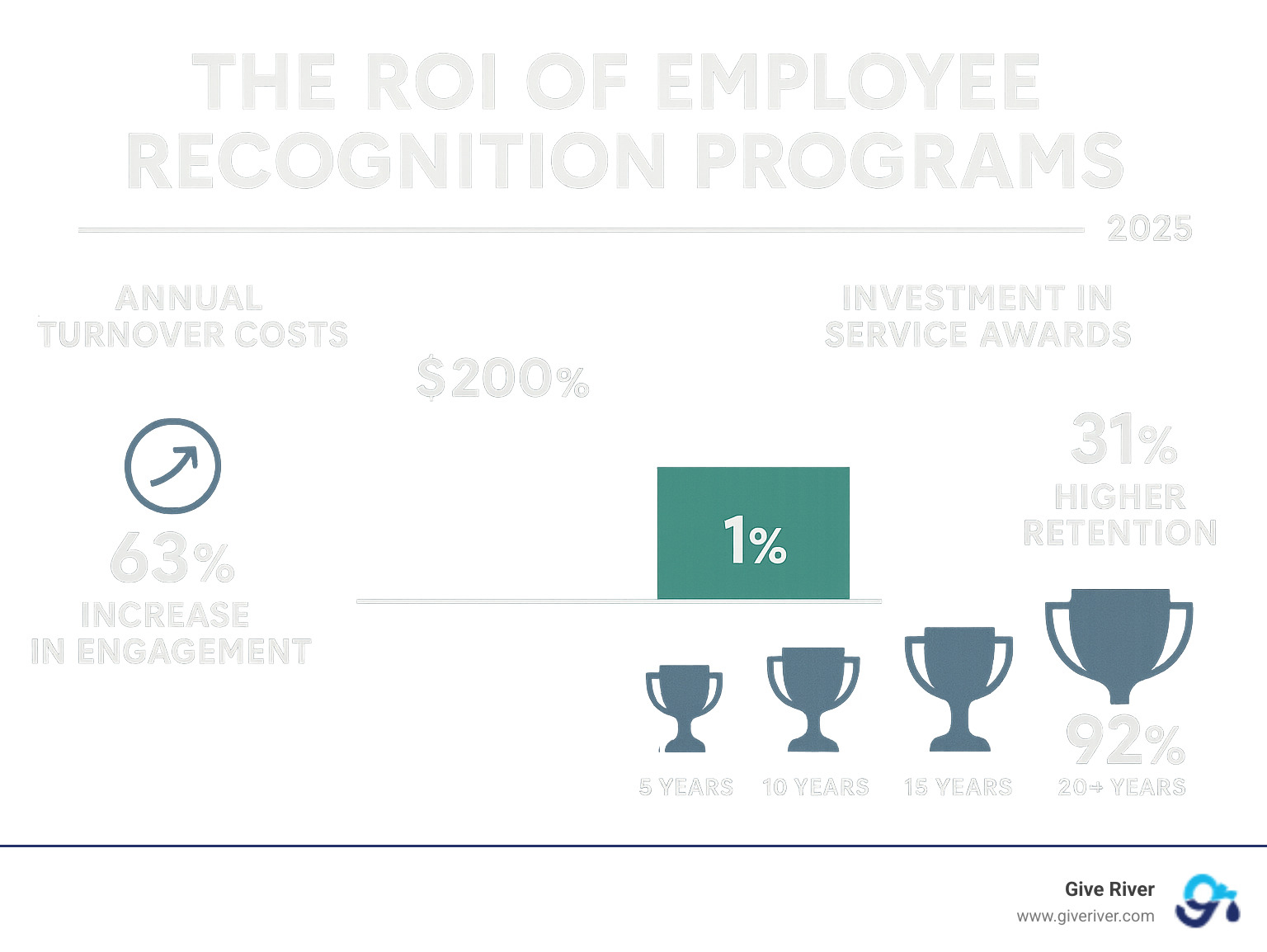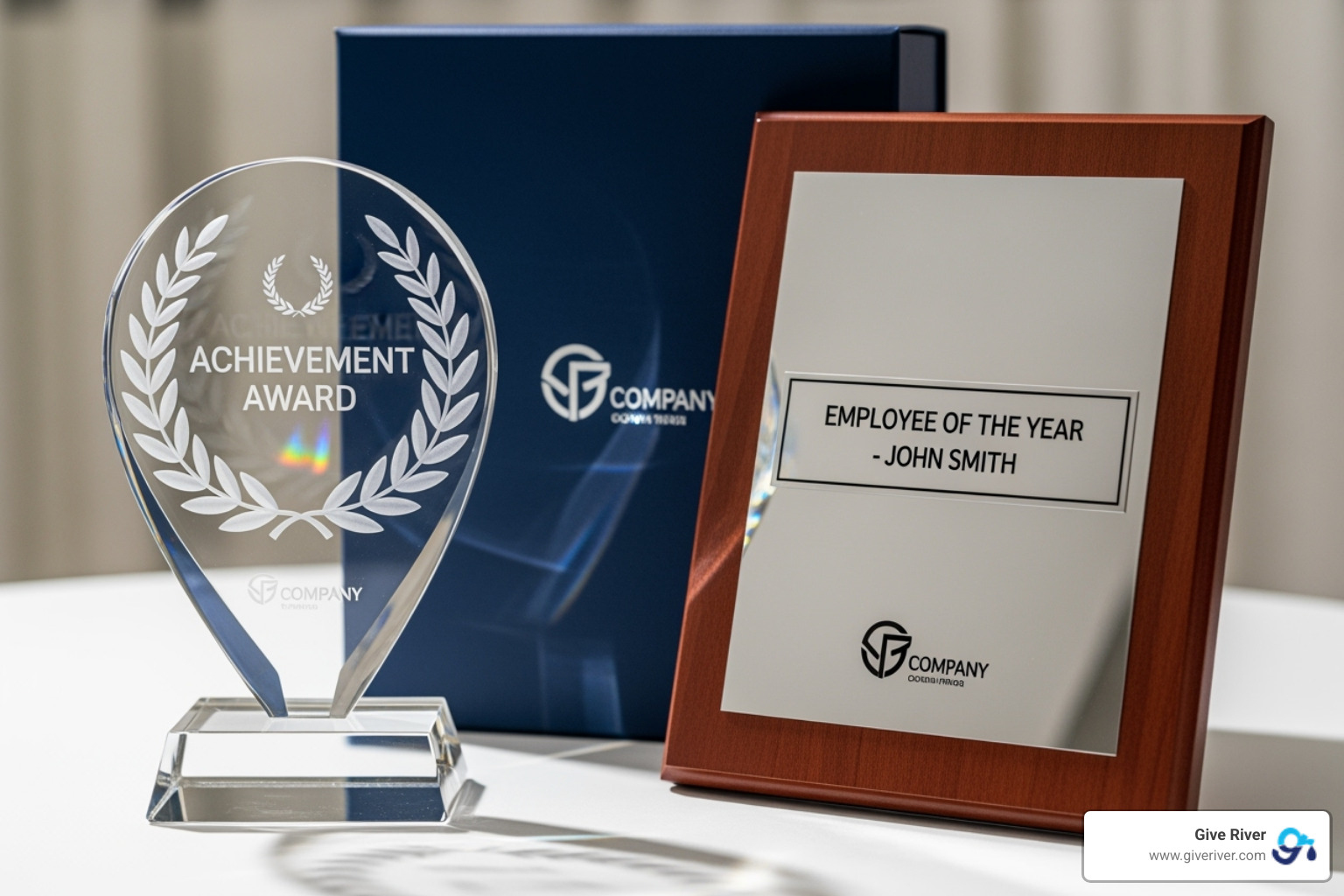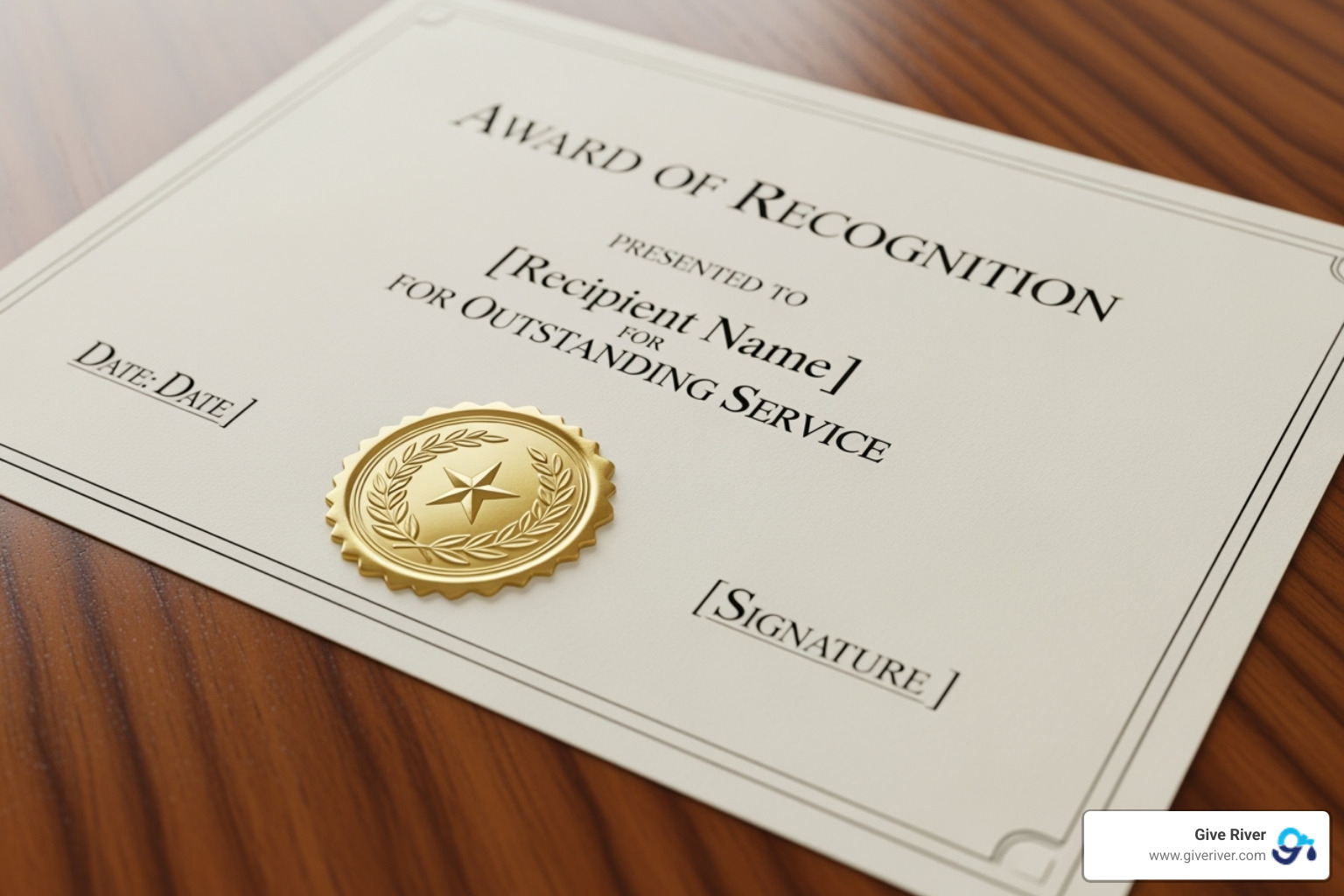Service Awards Explained: Honoring Dedication in Every Field
Unlock the power of service award programs. Learn to design, implement, and measure success for engagement & retention.

The Enduring Power of Recognizing Loyalty
A service award is a formal recognition given to employees, volunteers, or public servants to honor their years of dedicated service. These awards mark significant milestones—such as 5, 10, or 25 years—and can take various forms, from crystal trophies and certificates to branded gifts and experiential rewards.
Key Service Award Facts:
- Purpose: Recognize tenure milestones and foster loyalty
- Common intervals: 1, 5, 10, 15, 20, 25+ years of service
- Award types: Pins, plaques, certificates, crystal, gift boxes, experiences
- ROI impact: 31% lower voluntary turnover in companies with formal recognition programs
- Employee response: 69% of employees say they would work harder if better recognized
The numbers tell a compelling story. Companies with formal recognition programs experience 31% lower voluntary turnover, and 69% of employees report they would work harder if better recognized. Yet only 58% of organizations have a formal program, a missed opportunity considering replacing an employee can cost 50% to 200% of their annual salary.
Service awards span three categories: employee recognition for workplace tenure, volunteer awards for community service, and public service awards for government dedication. Each serves to honor sustained commitment and reinforce the value of loyalty.
The recognition landscape has evolved beyond generic plaques. Modern programs integrate with employee experience platforms, making recognition a part of daily operations. While platforms like Bonusly and Kudos excel at peer-to-peer recognition and points-based rewards, they often treat service awards as a standard, automated function. Innovative solutions like Give River transform this traditional recognition into a catalyst for personal growth and community impact.
My experience building the Give River platform has shown me that the most effective service award programs don't just celebrate the past; they inspire future dedication and growth.

Designing and Implementing a World-Class Service Award Program
Creating a meaningful service award program is about building something that genuinely celebrates your people and strengthens your culture. Let's walk through how to design a program that your employees will actually treasure.
Laying the Foundation: Milestones, Budgets, and Award Types
The foundation of any great program starts with defining what milestones matter and how to honor them. The sweet spot for recognition intervals typically starts at 1 year, followed by 3, 5, 10, 15, 20, and 25+ years. Each milestone should feel special, with the excitement growing as tenure deepens.
Your service award should reflect the significance of the milestone. For early milestones (1-3 years), personalized certificates or quality branded merchandise work well. As tenure increases, so should the value and symbolism of the award. The table below offers a strategic guide for matching awards to milestones.
| Years of Service | Award Types & Themes | Symbolism | Investment Range |
|---|---|---|---|
| 1-3 Years | Certificates, branded gifts, bronze pins | Bronze/Copper | $25 - $100 |
| 5 Years | Engraved plaques, sapphire-accented pins, blue crystal | Sapphire | $100 - $250 |
| 10 Years | Crystal trophies, diamond pins, experience vouchers | Diamond | $250 - $500 |
| 15 Years | Ruby crystal awards, personalized high-value gifts | Ruby | $500 - $750 |
| 20 Years | Emerald pins, custom awards, premium experiences | Emerald | $750 - $1,500 |
| 25+ Years | Silver trophies, luxury items, bucket-list experiences | Silver/Pearl/Gold | $1,500 - $3,000+ |
Remember the math: replacing an employee costs 50-200% of their salary, while companies with formal recognition see 31% lower turnover. A tiered budget that invests more in senior milestones is a direct investment in retention and culture. For more ideas, explore our guide on Workplace Rewards Ideas.

The Art of Recognition: Personalization and Presentation
A service award becomes a cherished memory through thoughtful personalization and presentation. The basics include the employee's name, years of service, and company logo. But what makes it great is a sincere, personalized message acknowledging their specific contributions.
For example: "Presented to [Name] in profound appreciation for [Number] years of exceptional service. Your commitment to [specific value or contribution] has been an inspiration to us all."
Presentation is just as critical. Present awards on or near the anniversary in a public setting, like a team meeting or company event. Leadership involvement amplifies the message that loyalty matters. For remote teams, mail the physical award to their home for a virtual ceremony and create digital recognition on internal platforms. A handwritten note adds a powerful, personal touch. For more creative approaches, check out our Staff Appreciation Ideas.

Building a Strategic Program: From Launch to Measurement
Implementing a successful program requires strategic thinking. Start by defining clear objectives (e.g., improve retention, boost morale) and securing leadership buy-in. Your program should embody company values and be built with diversity, equity, and inclusion in mind. This means ensuring ceremonies are accessible, criteria are objective, and processes are transparent.
Launch with enthusiasm, explaining the 'why' behind the program. Use recognition platforms to automate anniversary alerts and manage distribution. To measure success, track key metrics like employee engagement scores and voluntary turnover rates.
Service awards work best as part of a comprehensive ecosystem that includes spot, performance, and peer-to-peer recognition. While platforms like Bonusly and Kudos offer solid features for these individual recognition types, Give River's approach integrates these streams into a unified experience that fosters genuine fulfillment, preventing service awards from feeling siloed from day-to-day appreciation. Learn more in our guide to Employee Recognition Programs.
Navigating Compliance and Vendor Management for Your Service Award
Managing a program requires attention to tax rules, data, and vendors. In the U.S., non-cash length-of-service awards can often be excluded from an employee's gross income under a "qualified plan," but there are limits and specific rules. Always consult a qualified tax advisor to ensure compliance.
Your HRIS should be the single source of truth for start dates, and automation can ensure no milestone is missed. When choosing vendors, look for:
- High-quality craftsmanship
- Strong customization and proofing processes
- Reliable shipping and logistics
- Clear pricing and good customer support
Avoid common pitfalls like generic gifts, delays, personalization errors, and inconsistent application. Consider sustainable options like eco-friendly materials or experiential rewards to align with modern values. For more on selecting partners, see our insights on choosing an Employee Recognition Platform Vendor.
A Special Look at Public and Volunteer Service Awards
Recognizing dedication in public service and volunteerism is equally critical. While the motivation differs from corporate roles, the goal of honoring sustained commitment is the same.
- Federal Service: The Office of Personnel Management (OPM) authorizes official certificates with tiered seals (bronze, silver, gold) for federal employees marking 5 to 50+ years of service.
- Volunteer Service: The President's Volunteer Service Award (PVSA) offers national recognition for volunteer hours, managed by certified local organizations.
- State and National Awards: Programs like the Illinois Governor's Hometown and Volunteer Service Awards and the National Public Service Award honor outstanding contributions at all levels of government and in nonprofits. You can learn more through the Information on the National Public Service Award.
For nonprofits, track volunteer hours, create tiered recognition systems, and communicate the impact of their contributions. Across all sectors, ensure recognition is inclusive and accessible to all.

Conclusion: Making Every Milestone Matter
The journey through service award programs reveals a fundamental truth: recognizing loyalty isn't just about celebrating the past—it's about investing in your organization's future. Organizations with formal recognition programs see 31% lower voluntary turnover and find that 69% of employees work harder when they feel recognized. When you celebrate an individual's milestone, you send a powerful message to the entire team that dedication is valued and rewarded.
Looking ahead, the future of service recognition is more personalized and experience-focused. Empowering employees with choice—whether it's a tangible gift, a charitable donation, or a unique experience—ensures the award truly resonates. Showcasing the stories of past recipients also inspires others and reinforces the culture you want to build.
While platforms like Bonusly and Kudos offer valuable recognition features, they often focus on the transaction of points and rewards. The most impactful programs integrate service awards into a comprehensive employee experience. At Give River, our unique 5G Method moves beyond the transaction by connecting recognition with opportunities for growth, wellness, and community impact. This transforms a service award from a retrospective thank you into a forward-looking investment in an employee's continued journey.
A well-designed service award program doesn't just recognize tenure; it celebrates the human connection between individual dedication and organizational success. By making every milestone matter, you create a workplace where people don't just stay; they flourish.
Ready to transform your recognition strategy into a catalyst for employee fulfillment and organizational success?




